engine oil FIAT 124 SPIDER 2018 Owner handbook (in English)
[x] Cancel search | Manufacturer: FIAT, Model Year: 2018, Model line: 124 SPIDER, Model: FIAT 124 SPIDER 2018Pages: 220, PDF Size: 3.18 MB
Page 17 of 220
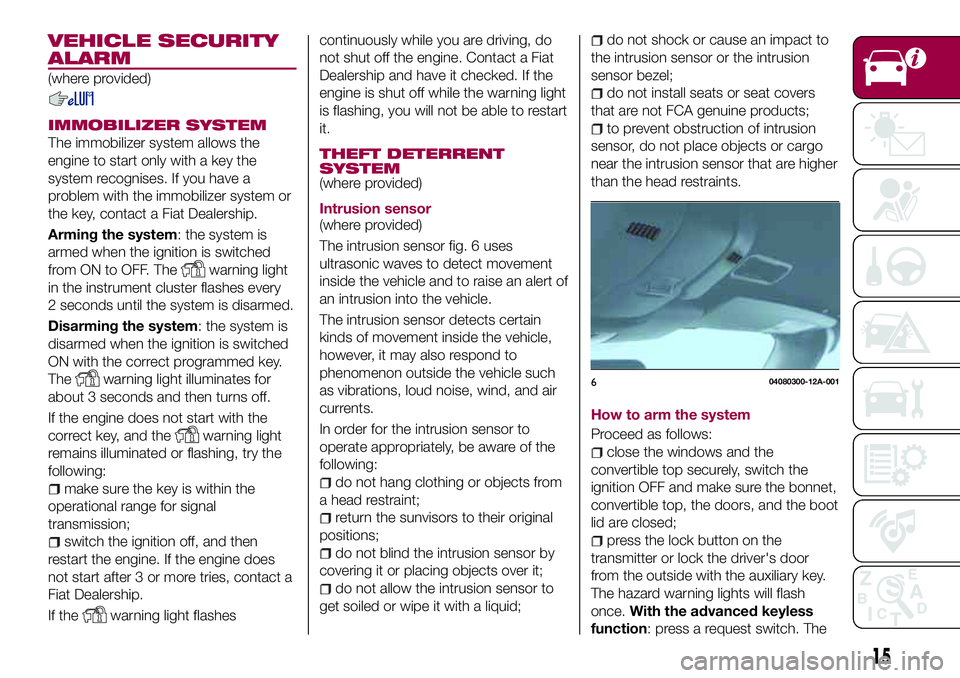
VEHICLE SECURITY
ALARM
(where provided)
IMMOBILIZER SYSTEM
The immobilizer system allows the
engine to start only with a key the
system recognises. If you have a
problem with the immobilizer system or
the key, contact a Fiat Dealership.
Arming the system: the system is
armed when the ignition is switched
from ON to OFF. The
warning light
in the instrument cluster flashes every
2 seconds until the system is disarmed.
Disarming the system: the system is
disarmed when the ignition is switched
ON with the correct programmed key.
The
warning light illuminates for
about 3 seconds and then turns off.
If the engine does not start with the
correct key, and the
warning light
remains illuminated or flashing, try the
following:
make sure the key is within the
operational range for signal
transmission;
switch the ignition off, and then
restart the engine. If the engine does
not start after 3 or more tries, contact a
Fiat Dealership.
If the
warning light flashescontinuously while you are driving, do
not shut off the engine. Contact a Fiat
Dealership and have it checked. If the
engine is shut off while the warning light
is flashing, you will not be able to restart
it.
THEFT DETERRENT
SYSTEM
(where provided)
Intrusion sensor
(where provided)
The intrusion sensor fig. 6 uses
ultrasonic waves to detect movement
inside the vehicle and to raise an alert of
an intrusion into the vehicle.
The intrusion sensor detects certain
kinds of movement inside the vehicle,
however, it may also respond to
phenomenon outside the vehicle such
as vibrations, loud noise, wind, and air
currents.
In order for the intrusion sensor to
operate appropriately, be aware of the
following:
do not hang clothing or objects from
a head restraint;
return the sunvisors to their original
positions;
do not blind the intrusion sensor by
covering it or placing objects over it;
do not allow the intrusion sensor to
get soiled or wipe it with a liquid;
do not shock or cause an impact to
the intrusion sensor or the intrusion
sensor bezel;
do not install seats or seat covers
that are not FCA genuine products;
to prevent obstruction of intrusion
sensor, do not place objects or cargo
near the intrusion sensor that are higher
than the head restraints.
How to arm the system
Proceed as follows:
close the windows and the
convertible top securely, switch the
ignition OFF and make sure the bonnet,
convertible top, the doors, and the boot
lid are closed;
press the lock button on the
transmitter or lock the driver's door
from the outside with the auxiliary key.
The hazard warning lights will flash
once.With the advanced keyless
function: press a request switch. The
604080300-12A-001
15
Page 45 of 220
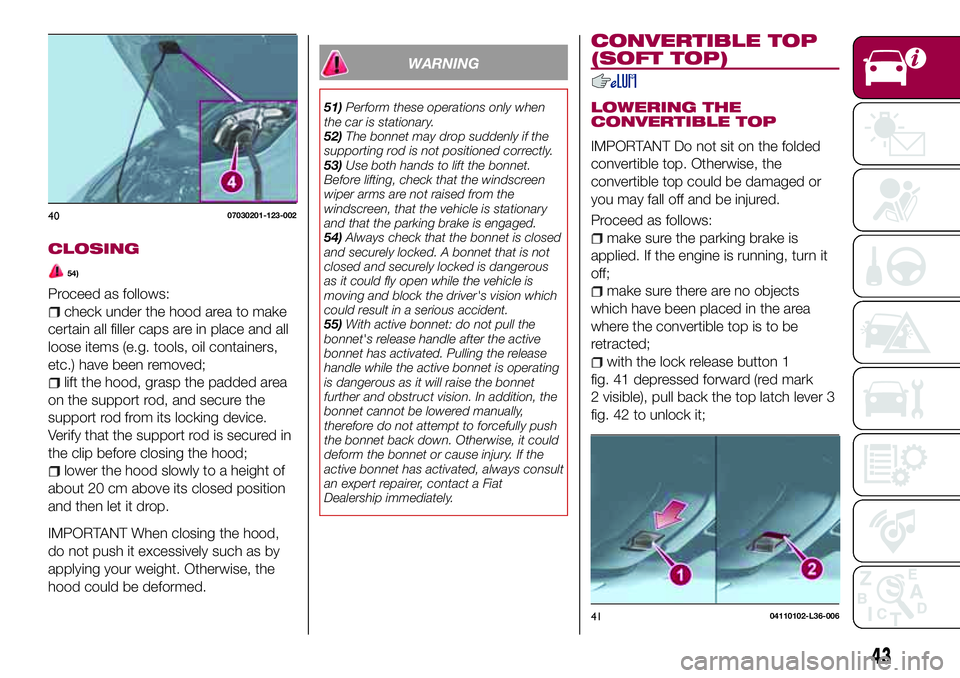
CLOSING
54)
Proceed as follows:
check under the hood area to make
certain all filler caps are in place and all
loose items (e.g. tools, oil containers,
etc.) have been removed;
lift the hood, grasp the padded area
on the support rod, and secure the
support rod from its locking device.
Verify that the support rod is secured in
the clip before closing the hood;
lower the hood slowly to a height of
about 20 cm above its closed position
and then let it drop.
IMPORTANT When closing the hood,
do not push it excessively such as by
applying your weight. Otherwise, the
hood could be deformed.
WARNING
51)Perform these operations only when
the car is stationary.
52)The bonnet may drop suddenly if the
supporting rod is not positioned correctly.
53)Use both hands to lift the bonnet.
Before lifting, check that the windscreen
wiper arms are not raised from the
windscreen, that the vehicle is stationary
and that the parking brake is engaged.
54)Always check that the bonnet is closed
and securely locked. A bonnet that is not
closed and securely locked is dangerous
as it could fly open while the vehicle is
moving and block the driver's vision which
could result in a serious accident.
55)With active bonnet: do not pull the
bonnet's release handle after the active
bonnet has activated. Pulling the release
handle while the active bonnet is operating
is dangerous as it will raise the bonnet
further and obstruct vision. In addition, the
bonnet cannot be lowered manually,
therefore do not attempt to forcefully push
the bonnet back down. Otherwise, it could
deform the bonnet or cause injury. If the
active bonnet has activated, always consult
an expert repairer, contact a Fiat
Dealership immediately.
CONVERTIBLE TOP
(SOFT TOP)
LOWERING THE
CONVERTIBLE TOP
IMPORTANT Do not sit on the folded
convertible top. Otherwise, the
convertible top could be damaged or
you may fall off and be injured.
Proceed as follows:
make sure the parking brake is
applied. If the engine is running, turn it
off;
make sure there are no objects
which have been placed in the area
where the convertible top is to be
retracted;
with the lock release button 1
fig. 41 depressed forward (red mark
2 visible), pull back the top latch lever 3
fig. 42 to unlock it;
4007030201-123-002
4104110102-L36-006
43
Page 56 of 220
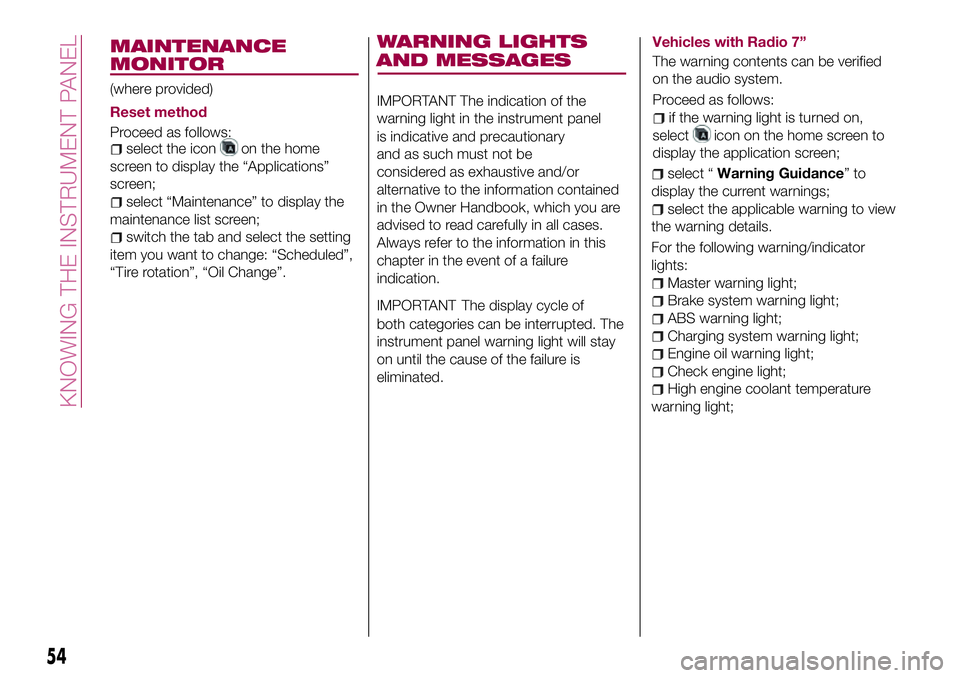
54
KNOWING THE INSTRUMENT PANEL
IMPORTANT The indication of the
warning light in the instrument panel
is indicative and precautionary
and as such must not be
considered as exhaustive and/or
alternative to the information contained
in the Owner Handbook, which you are
advised to read carefully in all cases.
Always refer to the information in this
chapter in the event of a failure
indication.
IMPORTANTThe display cycle of
both categories can be interrupted. The
instrument panel warning light will stay
on until the cause of the failure is
eliminated.
Vehicles with Radio 7”
The warning contents can be verified
on the audio system.
Proceed as follows:
if the warning light is turned on,
select
icon on the home screen to
display the application screen;
select “Warning Guidance”to
display the current warnings;
select the applicable warning to view
the warning details.
For the following warning/indicator
lights:
Master warning light;
Brake system warning light;
ABS warning light;
Charging system warning light;
Engine oil warning light;
Check engine light;
High engine coolant temperature
warning light;
AND MESSAGESWARNING LIGHTSMAINTENANCE
MONITOR
(where provided)
Proceed as follows:
select the iconon the home
screen to display the “Applications”
screen;
select “Maintenance” to display the
maintenance list screen;
switch the tab and select the setting
item you want to change: “Scheduled”,
“Tire rotation”, “Oil Change”.
Reset method
Page 59 of 220

Warning light What it means
LOW ENGINE OIL PRESSURE
This warning light indicates low engine oil pressure.
IMPORTANT Do not run the engine if the oil pressure is low. Otherwise, it could result in
extensive engine damage.
If the light illuminates or the warning indication is displayed while driving:
drive to the side of the road and park off the right-of-way on level ground;
turn off the engine and wait 5 minutes for the oil to drain back into the sump;
inspect the engine oil level. If it's low, add the appropriate amount of engine oil while being
careful not to overfill;
start the engine and check the warning light.IMPORTANT Do not run the engine if the oil level is low. Otherwise, it could result in extensive
engine damage.
If the light remains illuminated even though the oil level is normal or after adding oil, stop the
engine immediately and contact a Fiat Dealership.
DOOR-AJAR WARNING LIGHT
The light turns on if any door is not closed securely.
Close the door securely.
57
Page 159 of 220
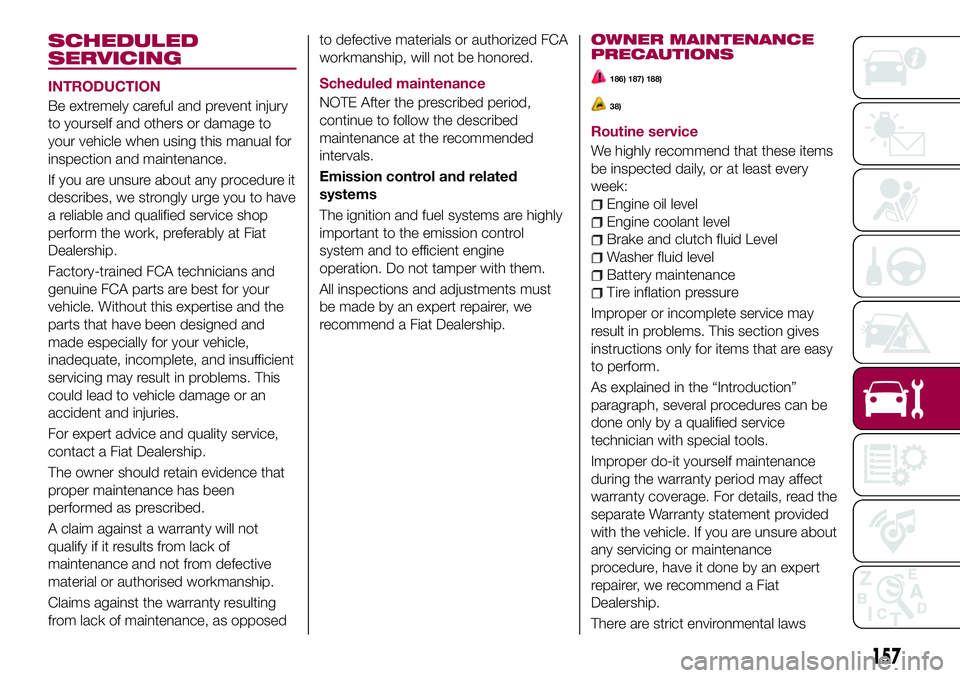
SCHEDULED
SERVICING
INTRODUCTION
Be extremely careful and prevent injury
to yourself and others or damage to
your vehicle when using this manual for
inspection and maintenance.
If you are unsure about any procedure it
describes, we strongly urge you to have
a reliable and qualified service shop
perform the work, preferably at Fiat
Dealership.
Factory-trained FCA technicians and
genuine FCA parts are best for your
vehicle. Without this expertise and the
parts that have been designed and
made especially for your vehicle,
inadequate, incomplete, and insufficient
servicing may result in problems. This
could lead to vehicle damage or an
accident and injuries.
For expert advice and quality service,
contact a Fiat Dealership.
The owner should retain evidence that
proper maintenance has been
performed as prescribed.
A claim against a warranty will not
qualify if it results from lack of
maintenance and not from defective
material or authorised workmanship.
Claims against the warranty resulting
from lack of maintenance, as opposedto defective materials or authorized FCA
workmanship, will not be honored.
Scheduled maintenance
NOTE After the prescribed period,
continue to follow the described
maintenance at the recommended
intervals.
Emission control and related
systems
The ignition and fuel systems are highly
important to the emission control
system and to efficient engine
operation. Do not tamper with them.
All inspections and adjustments must
be made by an expert repairer, we
recommend a Fiat Dealership.
OWNER MAINTENANCE
PRECAUTIONS
186) 187) 188)
38)
Routine service
We highly recommend that these items
be inspected daily, or at least every
week:
Engine oil level
Engine coolant level
Brake and clutch fluid Level
Washer fluid level
Battery maintenance
Tire inflation pressure
Improper or incomplete service may
result in problems. This section gives
instructions only for items that are easy
to perform.
As explained in the “Introduction”
paragraph, several procedures can be
done only by a qualified service
technician with special tools.
Improper do-it yourself maintenance
during the warranty period may affect
warranty coverage. For details, read the
separate Warranty statement provided
with the vehicle. If you are unsure about
any servicing or maintenance
procedure, have it done by an expert
repairer, we recommend a Fiat
Dealership.
There are strict environmental laws
157
Page 160 of 220
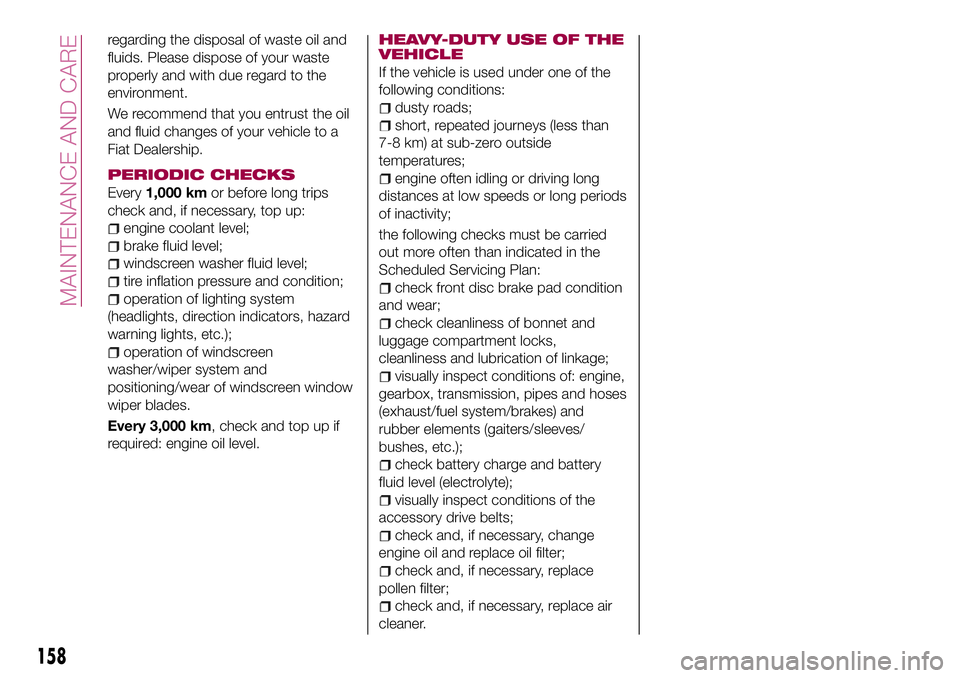
regarding the disposal of waste oil and
fluids. Please dispose of your waste
properly and with due regard to the
environment.
We recommend that you entrust the oil
and fluid changes of your vehicle to a
Fiat Dealership.
PERIODIC CHECKS
Every1,000 kmor before long trips
check and, if necessary, top up:
engine coolant level;
brake fluid level;
windscreen washer fluid level;
tire inflation pressure and condition;
operation of lighting system
(headlights, direction indicators, hazard
warning lights, etc.);
operation of windscreen
washer/wiper system and
positioning/wear of windscreen window
wiper blades.
Every 3,000 km, check and top up if
required: engine oil level.
HEAVY-DUTY USE OF THE
VEHICLE
If the vehicle is used under one of the
following conditions:
dusty roads;
short, repeated journeys (less than
7-8 km) at sub-zero outside
temperatures;
engine often idling or driving long
distances at low speeds or long periods
of inactivity;
the following checks must be carried
out more often than indicated in the
Scheduled Servicing Plan:
check front disc brake pad condition
and wear;
check cleanliness of bonnet and
luggage compartment locks,
cleanliness and lubrication of linkage;
visually inspect conditions of: engine,
gearbox, transmission, pipes and hoses
(exhaust/fuel system/brakes) and
rubber elements (gaiters/sleeves/
bushes, etc.);
check battery charge and battery
fluid level (electrolyte);
visually inspect conditions of the
accessory drive belts;
check and, if necessary, change
engine oil and replace oil filter;
check and, if necessary, replace
pollen filter;
check and, if necessary, replace air
cleaner.
158
MAINTENANCE AND CARE
Page 161 of 220
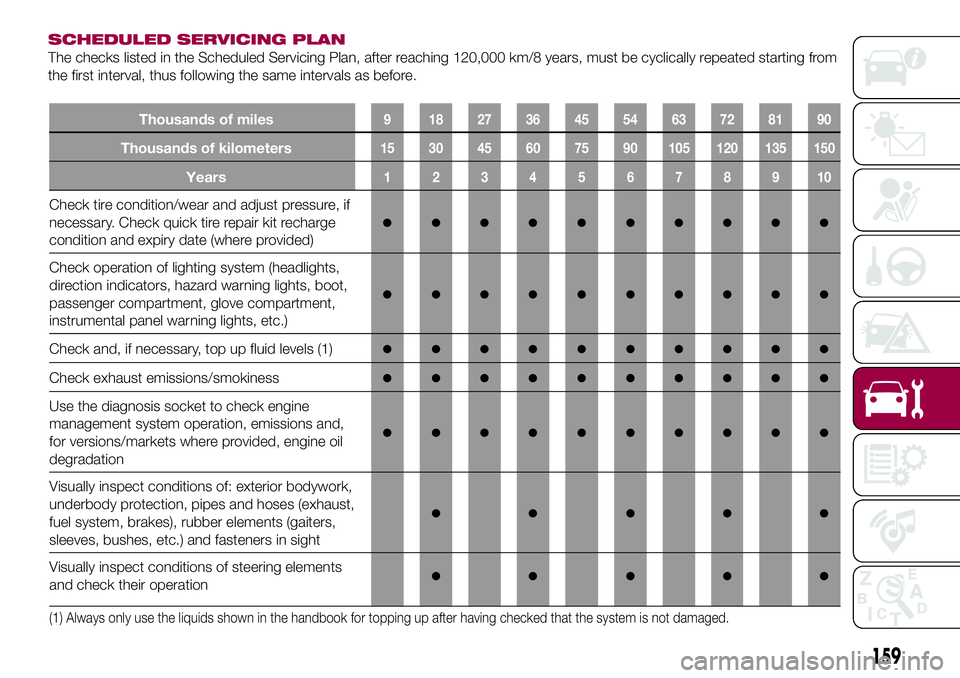
SCHEDULED SERVICING PLAN
The checks listed in the Scheduled Servicing Plan, after reaching 120,000 km/8 years, must be cyclically repeated starting from
the first interval, thus following the same intervals as before.
159
Thousands of miles9 182736455463728190
Thousands of kilometers15 30 45 60 75 90 105 120 135 150
Years12345678910
Check tire condition/wear and adjust pressure, if
necessary. Check quick tire repair kit recharge
condition and expiry date (where provided)
●●●●●●●●●●
Check operation of lighting system (headlights,
direction indicators, hazard warning lights, boot,
passenger compartment, glove compartment,
instrumental panel warning lights, etc.)
●●●●●●●●●●
Check and, if necessary, top up fluid levels (1)●●●●●●●●●●
Check exhaust emissions/smokiness●●●●●●●●●●
Use the diagnosis socket to check engine
management system operation, emissions and,
for versions/markets where provided, engine oil
degradation
●●●●●●●●●●
Visually inspect conditions of: exterior bodywork,
underbody protection, pipes and hoses (exhaust,
fuel system, brakes), rubber elements (gaiters,
sleeves, bushes, etc.) and fasteners in sight
●●●●●
Visually inspect conditions of steering elements
and check their operation●●●●●
(1) Always only use the liquids shown in the handbook for topping up after having checked that the system is not damaged.
Page 162 of 220
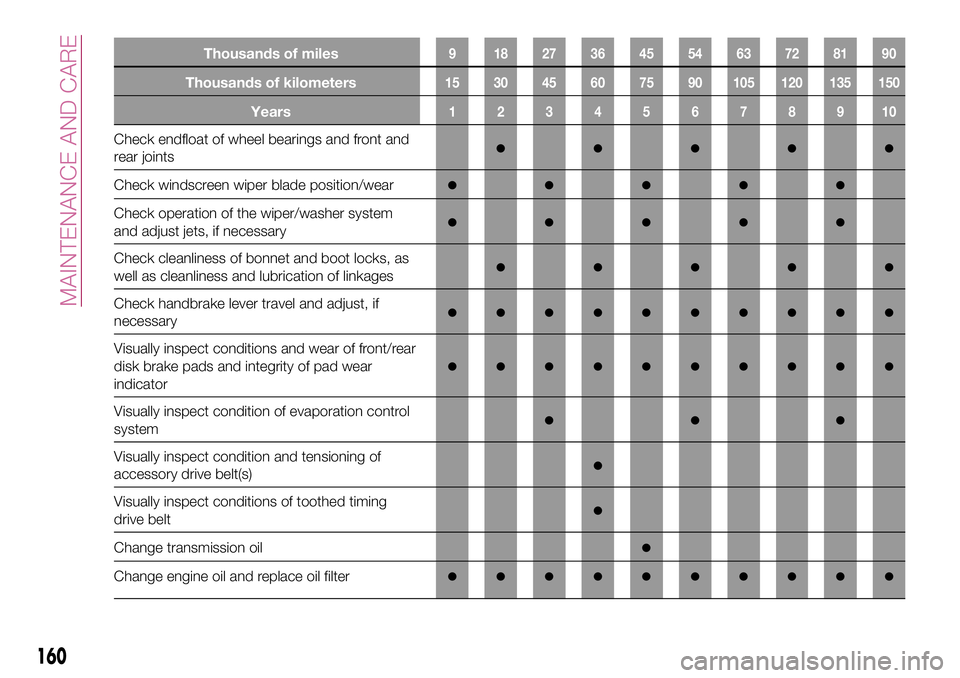
160
MAINTENANCE AND CARE
Thousands of miles9 182736455463728190
Thousands of kilometers15 30 45 60 75 90 105 120 135 150
Years12345678910
Check endfloat of wheel bearings and front and
rear joints●●●●●
Check windscreen wiper blade position/wear●●●●●
Check operation of the wiper/washer system
and adjust jets, if necessary●●●●●
Check cleanliness of bonnet and boot locks, as
well as cleanliness and lubrication of linkages●●●●●
Check handbrake lever travel and adjust, if
necessary●●●●●●●●●●
Visually inspect conditions and wear of front/rear
disk brake pads and integrity of pad wear
indicator
●●●●●●●●●●
Visually inspect condition of evaporation control
system●●●
Visually inspect condition and tensioning of
accessory drive belt(s)●
Visually inspect conditions of toothed timing
drive belt●
Change transmission oil●
Change engine oil and replace oil filter●●●●●●●●●●
Page 165 of 220
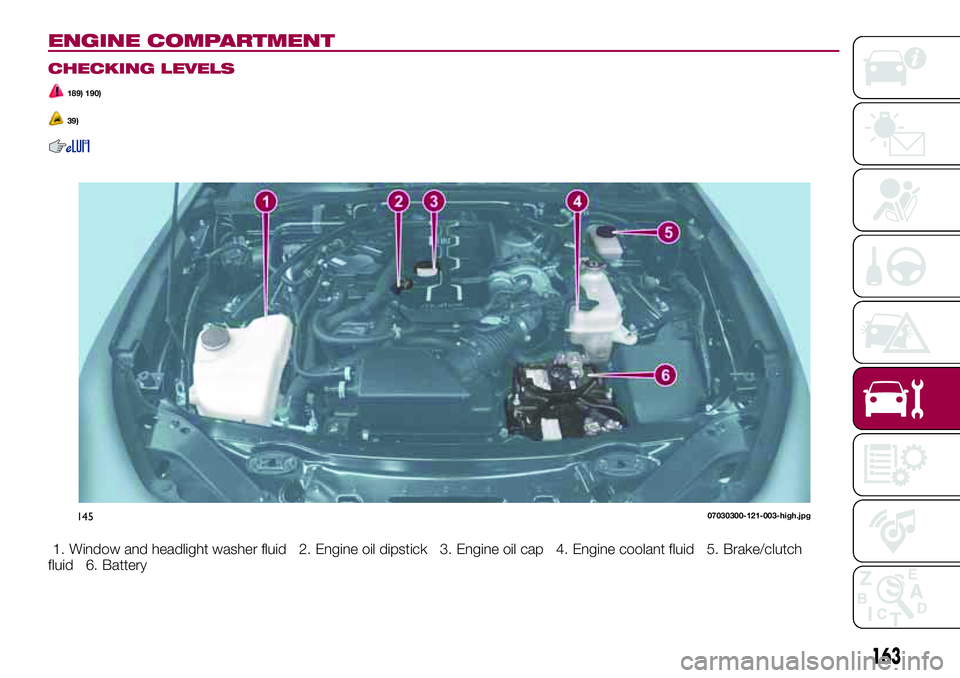
ENGINE COMPARTMENT
CHECKING LEVELS
189) 190)
39)
1. Window and headlight washer fluid 2. Engine oil dipstick 3. Engine oil cap 4. Engine coolant fluid 5. Brake/clutch
fluid 6. Battery
14507030300-121-003-high.jpg
163
Page 166 of 220
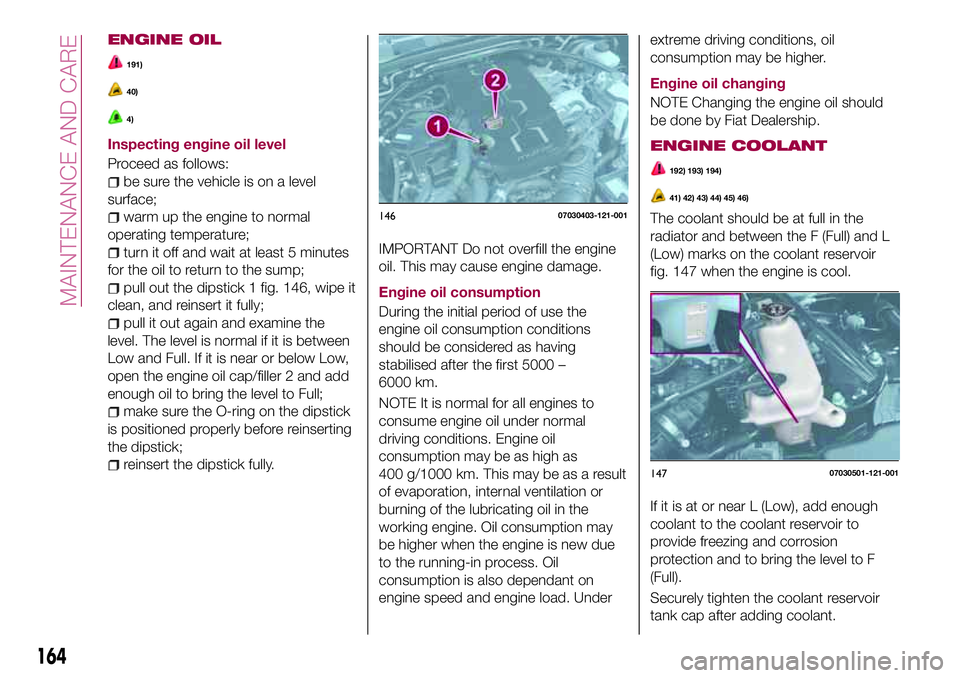
ENGINE OIL
191)
40)
4)
Inspecting engine oil level
Proceed as follows:
be sure the vehicle is on a level
surface;
warm up the engine to normal
operating temperature;
turn it off and wait at least 5 minutes
for the oil to return to the sump;
pull out the dipstick 1 fig. 146, wipe it
clean, and reinsert it fully;
pull it out again and examine the
level. The level is normal if it is between
Low and Full. If it is near or below Low,
open the engine oil cap/filler 2 and add
enough oil to bring the level to Full;
make sure the O-ring on the dipstick
is positioned properly before reinserting
the dipstick;
reinsert the dipstick fully.
IMPORTANT Do not overfill the engine
oil. This may cause engine damage.
Engine oil consumption
During the initial period of use the
engine oil consumption conditions
should be considered as having
stabilised after the first 5000 –
6000 km.
NOTE It is normal for all engines to
consume engine oil under normal
driving conditions. Engine oil
consumption may be as high as
400 g/1000 km. This may be as a result
of evaporation, internal ventilation or
burning of the lubricating oil in the
working engine. Oil consumption may
be higher when the engine is new due
to the running-in process. Oil
consumption is also dependant on
engine speed and engine load. Underextreme driving conditions, oil
consumption may be higher.
Engine oil changing
NOTE Changing the engine oil should
be done by Fiat Dealership.
ENGINE COOLANT
192) 193) 194)
41) 42) 43) 44) 45) 46)
The coolant should be at full in the
radiator and between the F (Full) and L
(Low) marks on the coolant reservoir
fig. 147 when the engine is cool.
If it is at or near L (Low), add enough
coolant to the coolant reservoir to
provide freezing and corrosion
protection and to bring the level to F
(Full).
Securely tighten the coolant reservoir
tank cap after adding coolant.14607030403-121-001
14707030501-121-001
164
MAINTENANCE AND CARE